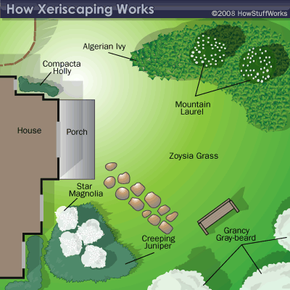Principles of Xeriscaping: Design, Turf and Plant Selection
Planning and design
Whether the area in question is as modest as someone's backyard or as expansive as a city park, the first part of Xeriscaping starts with a basic plan with pen and paper. First, landscapers draw up a base plan. This is simply a major outline of the landscape drawn to scale, including the location of houses, driveways and any plants that are already there. The second step involves making a bubble diagram. Over a copy of the base plan, descriptive notes can go over areas that need Xeriscaping -- which water-thirsty plants need to go; which drought-resistant plants will replace the old ones; and other things like turf area and places to put barbecue pits, benches and paths. The bubble diagram will be used for the final landscape plan, which clearly defines the eventual Xeriscape project.
Creating practical turf areas
It takes a lot of water to maintain grass lawns and keep them green, so a good look at the use of turf areas is important to Xeriscaping. This doesn't mean all grass has to be removed and replaced with gravel. A designer just needs to take into account where grass will be useful and enhance the landscape, not take away (both physically and visually) from the other plant life. Places that get a lot of foot traffic, for instance, will be trampled on if there's grass, so walkways or ground cover can replace existing turf.
Advertisement
There are also many different types of grasses, some of which are seasonal, some of which are native to a certain region and work better with low water usage. You can check with your local gardening center to see which kind of grass is best suited for your landscape.
Plant selection
Choosing the right plants is, to many, the most important part. These plants will be the main attraction and define the landscape. But the location and grouping of plants can greatly affect the amount of water used,
First of all, native plants are usually the best choice for a Xeriscaping project. Although it's possible to use plants from other regions, there's a chance that outside vegetation won't adapt quickly to a new locale, and you'll be stuck with an empty lawn. It's also important, of course, that the plants are drought-tolerant and don't require much water -- local gardening centers that participate in Xeriscaping should have extensive lists of the kinds of plants that will work. The University of Georgia's College of Agricultural and Environmental Sciences also lists several acceptable plants at the bottom of this page.
Picking the plants and sticking them into the ground isn't enough, though. We might not think about it often, but the location of plant life in a landscape is very important in determining how they will grow and how much water they'll use. For instance, plants that need more sunlight grow best when they're placed on the western side of a landscape -- that way they'll receive the most possible sunlight as the sun rises in the east and sets in the west. Whether plants are located high or low on a landscape is also important. Plants that need very little water can sit at higher elevations, while ones that need more can sit lower to collect any excess water.
For the remaining principles of Xeriscaping, see the next page.
